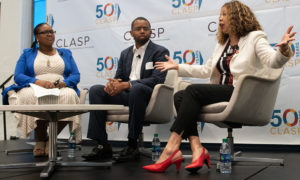
fizkes/Shutterstock
.
Over the past five years, public awareness of the plight and promise of young people who are not in school or the workforce has grown by leaps and bounds.
This awareness, combined with an economy that has bounced back from the financial crisis a decade ago and concerted efforts by business, government and philanthropy to reconnect these young people, has yielded positive results.

Rebecca Gluskin
Today, fewer young people are disconnected from school and work than there were before the Great Recession. But challenges remain for this group, known as “disconnected” or “opportunity” youth: 4.6 million young women and men are still cut off from the educational and employment

Kristen Lewis
opportunities required for a secure, rewarding adulthood.
Until now, research on disconnected youth has largely been based on one-year snapshots in time provided by data from the annual American Community Survey, including our own Disconnected Youth Series, which first calculated youth disconnection data in the U.S. in 2012.
Our latest research, made possible by the Schultz Family Foundation, “Two Futures: The Economic Case for Keeping Youth on Track,” breaks new ground by following a specific group of youth over time, using data from two Panel Study of Income Dynamics (PSID) cohorts and by investigating the share of disconnected youth who reported that they were disconnected for more than two or three years. Begun in 1968, the University of Michigan’s PSID has been called “one of the most remarkable surveys of American families ever conducted” because it enables researchers to analyze change over generations in American households.
We followed two groups of young people over time. Those in the first group either had a job or were in school at the time of the first survey, taken when they were in their late teens or early 20s; those in the second group were neither working nor in school at that time. The stark differences we found surprised us: The data essentially showed two futures unfolding, one for connected young people and another for disconnected young people.
The differences were not apparent right away; a few years after the initial survey, outcomes for the two groups were similar. But by the time they reached their early 30s, striking differences in educational attainment, earnings, home ownership, employment and health outcomes had emerged.
Roughly 15 years after the initial survey, those who had been working or in school as teens and young adults earned $31,000 more per year and were 45 percent more likely to own a home, 42 percent more likely to be employed and 52 percent more likely to report excellent or good health than those who had been disconnected as young people.
Disconnection means income penalty years later
Importantly, the effects of disconnection persisted even when we compared adolescents and young adults from families with the same income levels and demographic characteristics. The data showed that a disconnected youth suffered, on average, an earnings penalty of more than $30,000 per year in middle adulthood as compared to a connected youth from a family with the same income.
The late teens and early 20s, a period known as “emerging adulthood,” are critical years for laying the groundwork for a healthy, productive life. Through school and work, young people earn credentials, gain knowledge, build professional networks, learn the unwritten rules of the workplace and develop the self-knowledge, self-control and self-confidence necessary for a thriving adulthood. Disconnected youth are cut off from these vital opportunities, and the personal, societal and economic deficits that result can linger for decades and span generations.
Vigorous efforts to help young people finish school and get connected to jobs are in everyone’s interest. In previous reports, we’ve identified steps for government and schools to take, such as investing in high-quality early childhood education and care; acting on early-warning signs for drop-out; ending punitive disciplinary approach that harm, in particular, boys of color; and linking high school curricula to community college career and technical training programs and apprenticeships to create clear pathways from school to work. Business also has an important role to play. Investing in early-career workers can provide positive returns to employers as well as employees.
Here’s how the private sector can help:
- Listen and respond to the views and voices of youth themselves to better understand and address the challenges they face, such as reliable transportation to work.
- Support at-risk, first-time workers with training and supportive policies that help them stay employed.
- Work together across fractured systems. Businesses can support and even spur collective action among schools, the criminal justice system, health care systems, financial systems, philanthropy, workforce development boards and others to tackle the unequal conditions of daily life that persist in high-disconnection communities.
- Set data-driven goals and measure progress toward them.
We often think of out-of-school and out-of-work young people as a cost to society, but a much better way to think about them is as an untapped resource. These are individuals who could be paying taxes, working and creating jobs, buying houses, spending money to support local businesses and raising the next generation with economic security.
For example, given the difference in earnings we found between the connected and disconnected, we estimate that the federal government would gain, on average, $11,900 per year in additional tax revenue for each young person who remains connected. Multiply that by the 4.6 million disconnected youth today, and we get roughly $55 billion in potential federal revenue gain per year.
The data are clear: It’s in all of our interest to ensure that American young people — regardless of their ZIP code — develop the social, emotional, cognitive and technical skills they need to thrive as adults. Now is the time for businesses, governments, philanthropists and advocates to join forces to ensure that all our young people have a fair shot at a bright future, for their sake and ours.
Kristen Lewis is director of Measure of America, a project of the Social Science Research Council.
Rebecca Gluskin is deputy director and chief statistician of Measure of America.































